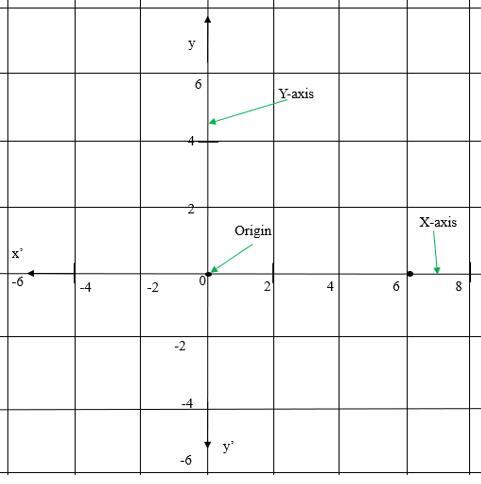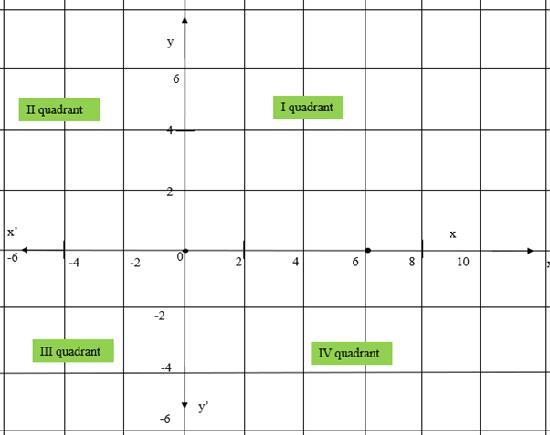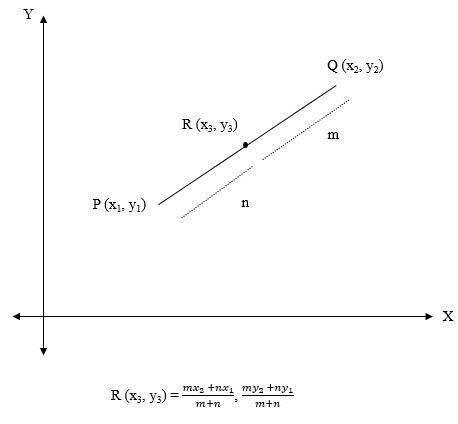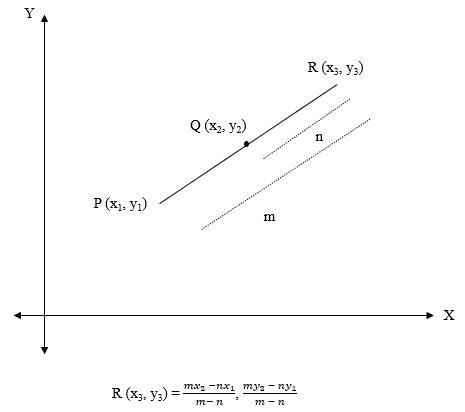
 Data Structure
Data Structure Networking
Networking RDBMS
RDBMS Operating System
Operating System Java
Java MS Excel
MS Excel iOS
iOS HTML
HTML CSS
CSS Android
Android Python
Python C Programming
C Programming C++
C++ C#
C# MongoDB
MongoDB MySQL
MySQL Javascript
Javascript PHP
PHP
- Selected Reading
- UPSC IAS Exams Notes
- Developer's Best Practices
- Questions and Answers
- Effective Resume Writing
- HR Interview Questions
- Computer Glossary
- Who is Who
Ordinate
Introduction
Ordinate is the second component in the ordered pair (x, y). There are two major branches of mathematics, including algebra and geometry. Both have separate uses and applications. However, the French mathematician Rene Descartes derived a concept through the combination of algebra and geometry. This concept helps us to express the location of any object, point, or line in the coordinate system. However, there are various topics included in the coordinate system. In this tutorial, we will learn about the coordinate system, the cartesian plane, its components (ordinate and abscissa), and some basic formulas with solved examples.
Coordinate System
In Euclidean space, the location of any point can be specified on the coordinate system. There are four types of coordinate systems commonly used in mathematics.
Number line The number line is a straight line containing positive integers on the right side of zero and negative integers on the left side of zero.
Cartesian plane The cartesian plane contains two perpendicular line segments graduated with integers.
Polar coordinate system In this type of coordinate system, the points are expressed in the form of (?, ?).
Cylindrical and spherical coordinate system In this type of coordinate system, the polar coordinates of a point are expressed in the form of (?, ?, ?).
Cartesian Plane
The cartesian plane contains two perpendicular line segments graduated with integers. Any point can be represented by paired coordinates such as (x, y). The x represents the X-axis coordinate, and the y represents the Y-axis coordinate. The schematic representation of a cartesian plane is given below.

There are three components in a coordinate plane.
Axis The horizontal and vertical axis are known as the X-axis and Y-axis, respectively.
Origin The point at which both axes of the plane intersect each other is called the origin. The coordinate of the origin is (0, 0).
Quadrant Four quadrants are present in the cartesian plane, shown in the following figure

Ordinates
We know that any point can be represented by paired coordinates such as (x, y). The second term or component of the coordinates is known as ordinates. In other words, the Y-axis coordinate of the point is said to be ordinate of that point. For example, the coordinate of a point is (6, -4). The ordinate of the point is -4. The quadrants decide the sign of the ordinate of the point.
I quadrant, y > 0
II quadrant, y > 0
III quadrant, y < 0
IV quadrant, y < 0
Abscissa
The first term or component of the coordinates is known as abscissa. In other words, the X-axis coordinate of the point is said to be abscissa of that point. For example, the coordinate of a point is (4, -5). The abscissa of the point is 4. The quadrants decide the sign of the abscissa of the point.
I quadrant, x > 0
II quadrant, x < 0
III quadrant, x < 0
IV quadrant, x > 0
Distance Formula
The length of a line segment can also be evaluated by using the distance formula. In cartesian geometry, a point is represented as (x, y) (where x = X-axis value, y = Y-axis value). The coordinate of the two endpoints of a line segment can be represented as A(?1, ?1) and B(?2, ?2). Then, according to the distance formula, the length of the segment can be obtained by using the following expression.
$$\mathrm{\overline{AB}\:=\:\sqrt{(x_{2}\:-\:x_{1})^{2}\:+\:(y_{2}\:-\:y_{1})^{2}}}$$
Section Formula
We know that a point is usually used to divide a line segment into two parts. Therefore, the determination of the position of the dividing point in coordinate geometry is known as the section formula. There are two types of sections formula that exist in coordinate geometry such as
Internal section formula
External section formula
Now, we will discuss the formula of each section in detail.
Internal section formula:
For example, consider a line segment having coordinates of the end point ?(?1, ?1) and ?(?2, ?2). A point ?(?3, ?3) is internally divided by the line segment in a ratio of m:n (as shown in the figure). Now, the coordinate of the point ?(?3, ?3) can be determined using the following formula.
$$\mathrm{R(x_{3}\:,\:y_{3})\:=\:(\frac{mx_{2}\:+\:nx_{1}}{m\:+\:n}\:,\:\frac{my_{2}\:+\:ny_{1}}{m\:+\:n})}$$

External section formula:
For example, consider a line segment having coordinates of the end point ?(?1, ?1) and ?(?2, ?2). A point ?(?3, ?3) is externally divided by the line segment in a ratio of m:n (as shown in the figure). Now, the coordinate of the point ?(?3, ?3) can be determined using the following formula.
$$\mathrm{R(x_{3}\:,\:y_{3})\:=\;(\frac{mx_{2}\:-\:nx_{1}}{m\:-\:n}\:,\:\frac{my_{2}\:-\:ny_{1}}{m\:-\:n})}$$

Area Formula
The formula to determine the area of various geometrical structures is mentioned below.
| S.N. | Geometry | Area formula | Variables |
|---|---|---|---|
| 1 | Square | $\mathrm{a\times\:a\:=\:a^{2}}$ | a = side of the square |
| 2 | Rectangle | $\mathrm{l\times\:b}$ | l = length b = width |
| 3 | Circle | $\mathrm{\pi\:\times\:r^{2}}$ | r = radius of the circle |
| 4 | Triangle | $\mathrm{\frac{1}{2}\times\:b\times\:h}$ | b = base of the triangle h = height of the triangle |
| 5 | Trapezoid | $\mathrm{\frac{1}{2}\times\:(a\:+\:b)\times\:h}$ | a = base length (1) b = base length (2) h = height |
| 6 | Ellipse | $\mathrm{\pi\:\times\:a\:\times\:b}$ | a = radius of major axis b = radius of minor axis |
Solved Examples
1)The cartesian coordinates of the endpoints of a line segment are A (0, -4) and B(3, 6). Calculate the length of ??.
Answer The coordinates of the endpoints are given that A (0, -4) and B(3, 6).
According to the distance formula, the length of the line segment will be
$$\mathrm{\overline{AB}\:=\:\sqrt{(x_{2}\:-\:x_{1})^{2}\:+\:(y_{2}\:-\:y_{1})^{2}}}$$
Here, $\mathrm{x_{1}\:=\:0\:,\:x_{2}\:=\:3\:,\:y_{1}\:=\:-4\:,\:y_{2}\:=\:6}$
Now, $\mathrm{\overline{AB}\:=\:\sqrt{(3\:-\:0)^{2}\:+\:(6\:-\:(-4))^{2}}}$
$\mathrm{\overline{AB}\:=\:\sqrt{(3)^{2}\:+\:(10)^{2}}}$
$\mathrm{\overline{AB}\:=\:\sqrt{109}\:\simeq\:10.44\:cm}$
? The length of the line segment is 10.44 cm
2)The coordinates of the endpoints of a line segment are (-10, 5) and (7, -3). A point on the x-axis divides the line segment externally in a ratio of m:n. Find the value of m:n
Answer It is given that,
The coordinates of the endpoints of the line segment = (-10, 5) and (7, 3)
Comparing with the standard coordinates, $\mathrm{x_{1}\:=-10\:,\:x_{2}\:=\:7\:,\:y_{2}\:=\:3}$
The external division ratio = m:n
Since the point is located on the x-axis, the y-coordinate of the point is 0.
Using the external section formula,
$$\mathrm{R(x_{3}\:,\:y_{3})\:=\:(\frac{mx_{2}\:-\:nx_{1}}{m\:-\:n}\:,\:\frac{my_{2}\:-\:ny_{1}}{m\:-\:n})}$$
$$\mathrm{R(x_{3}\:,\:0)\:=\:(\frac{m\times\:7\:-\:n\times\:(-10)}{m\:-\:n}\:,\:\frac{m\times\:(3)\:-\:n\times\:5}{m\:-\:n})}$$
$$\mathrm{R(x_{3}\:,\:0)\:=\:\frac{7m\:+\:10n}{m\:-\:n}\:,\:\frac{3m\:-\:5n}{m\:-\:n}}$$
Now, comparing y-cordinates on both sides, we get
$$\mathrm{\frac{3m\:-\:5n}{m\:-\:n}\:=\:0}$$
$$\mathrm{\Longrightarrow\:3m\:-\:5n\:=\:0\times\:(m\times\:n)\:=\:0}$$
$$\mathrm{\Longrightarrow\:3m\:=\:5n}$$
$$\mathrm{\Longrightarrow\:\frac{m}{n}\:=\:\frac{5}{3}}$$
?The given point divided the line segment externally in the ratio of 5:3.
Conclusion
The present tutorial gives a brief introduction to the coordinate system and its various components. The basic definition of the coordinate system, cartesian plane, ordinate, and abscissa has been stated in this tutorial. In addition, the procedure to determine the distance between two points, section formulae, and area formulae have been illustrated. Moreover, some solved examples have been provided for better clarity of this concept. In conclusion, the present tutorial may be useful for understanding the basic concept of the ordinate and coordinate system.
FAQs
1. Identify the quadrant of the given point: (7, -9).
Since the x-coordinated is positive and the y-coordinate is negative, the point lies in the IV quadrant.
2. What is the coordinate of the origin?
In the cartesian plane, the coordinate of the origin is (0, 0).
3. When plotting a point in the coordinate system, which direction should you go first?
While locating the point in the cartesian plane, we should locate the x- coordinate first. Then, we will locate the y-coordinate
4. Can we determine the length of the line segment using the section formula?
No, we have to apply the distance formula to determine the length of a line segment.
5. Can the ratio m:n be negative in the section formula?
Yes. In external division, the ratio m:n is a negative value.

